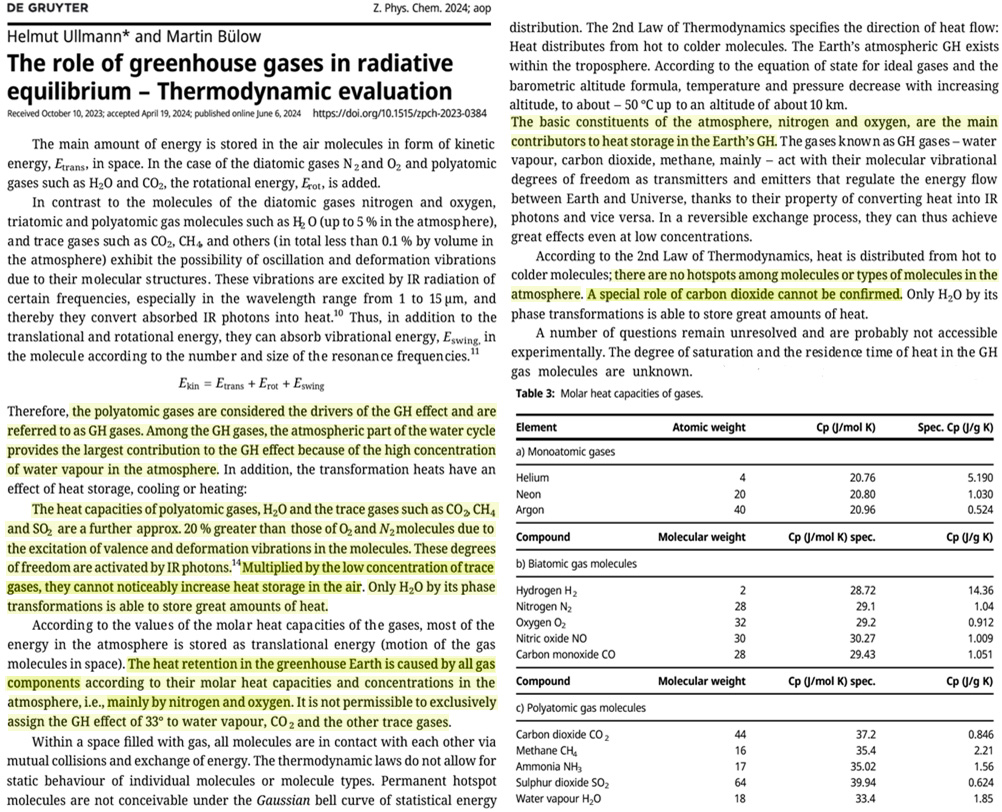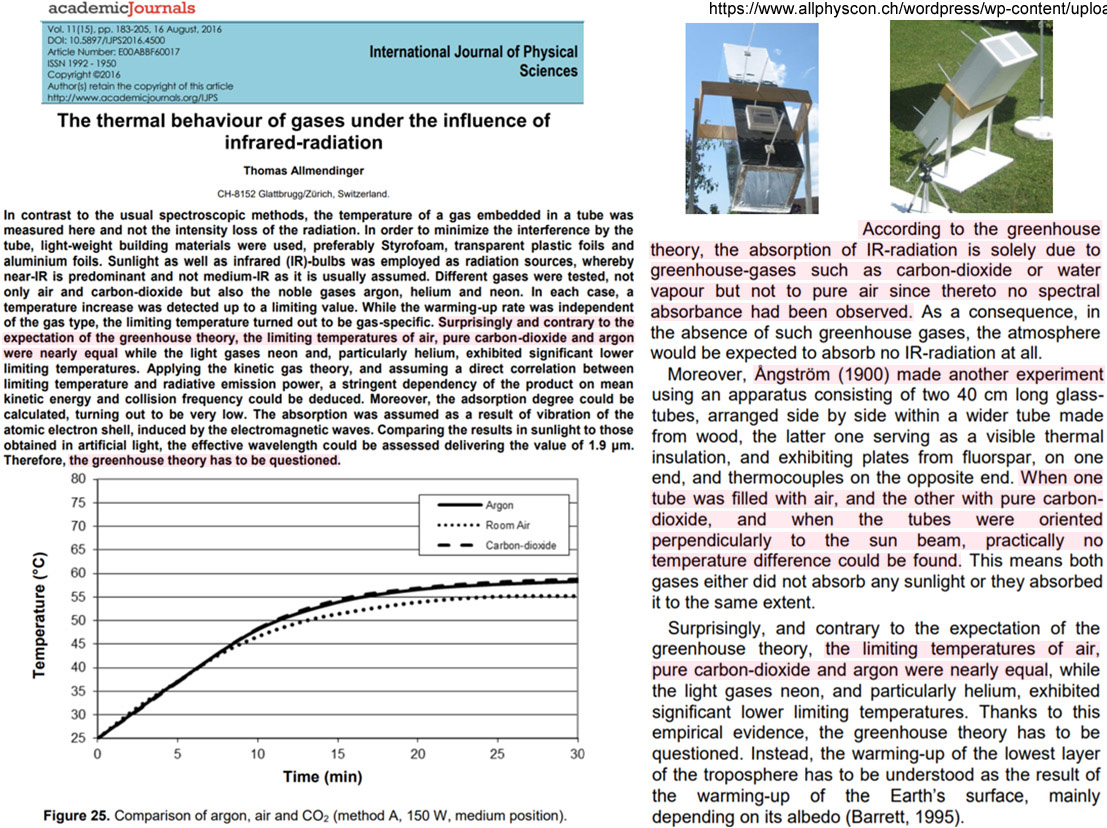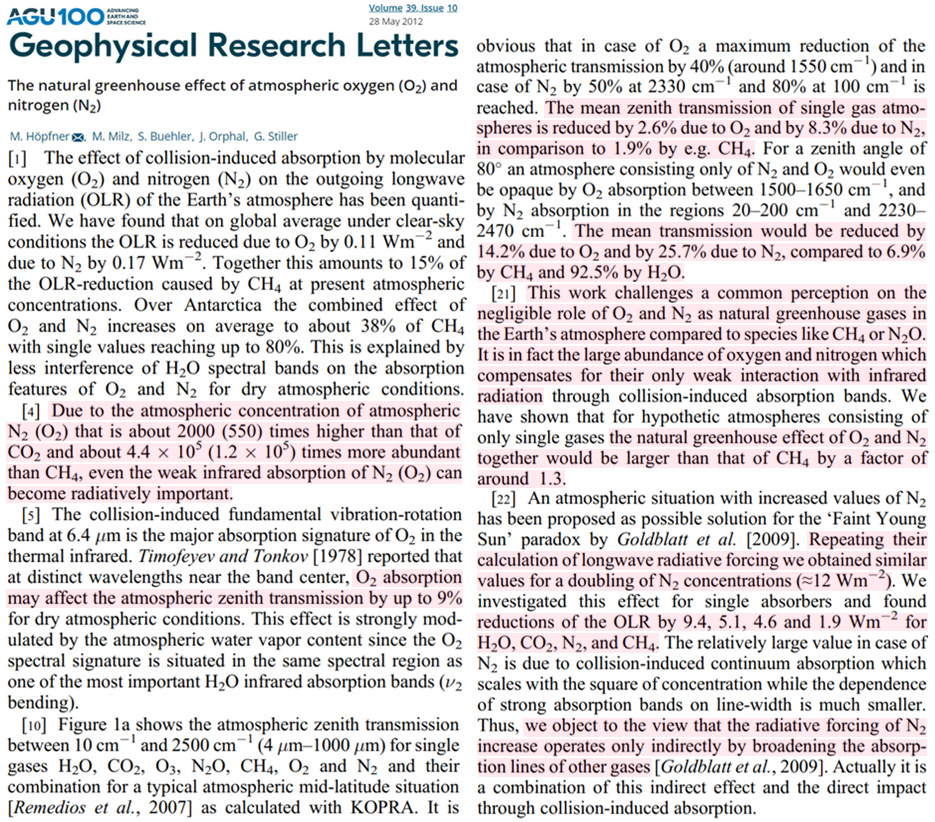“The heat retention in the greenhouse Earth is caused by all gas components…mainly by nitrogen and oxygen. It is not permissible to exclusively assign the GH effect of 33° to water vapour, CO2, and the other trace gases.” – Ullman and Bülow, 2024
Chemical physicists Helmut Ullman and Martin Bülow have published a new paper detailing the lack of meaningful or noticeable “specialness” that trace greenhouse gases like carbon dioxide (CO2, 0.042% of the atmosphere) and methane (CH4, 0.00018%) possess in determining Earth’s greenhouse effect heating.

Image Source: Ullman and Bülow, 2024
The imagined 33°C greenhouse effect thought experiment
The popularized greenhouse effect thought experiment requires imagining what temperature the Earth would be if there were no atmospheric greenhouse gases (water vapor, CO2, CH4). It is believed these trace (less than 0.1% of the atmospheric composition combined) heat-absorbing gaseous agents, combined with water vapor (up to 4% of the atmosphere in tropical areas), are the only gases capable of restricting heat loss to space. Thus, greenhouse gases are thought to ultimately keep the Earth’s land and ocean surface temperature 33°C warmer (288 K vs. 255 K) than it would otherwise be in their imagined absence.
It is simultaneously imagined that even though oxygen (O2, 21%), nitrogen (N2, 78%), and argon (Ar, 0.9%) together account for 999,000 ppm (99.9%) of the atmosphere’s gaseous composition, none of these gases absorb and re-emit heat, and thus they cannot slow cooling or count as contributors to the imagined 33°C warmer Earth atmosphere. Only the trace gases and water vapor – the so-called greenhouse gases – can slow cooling, or retain heat.
That’s what the thought experiment says, anyway. Physics say otherwise.
The O2 and N2 greenhouse effect
Ullmann and Bülow point out that the greenhouse effect is not only not exclusively determined by trace greenhouse gases like CO2 or CH4, but these trace gases play such an unimportant role that they’re not even noticeable. Only water vapor has the capacity to absorb heat to a degree that is detectable. The primary gaseous determinants of Earth’s greenhouse effect are not trace gases like CO2 and CH4, but, consistent with their atmospheric abundance, N2 and O2.
“The basic constituents of the atmosphere, nitrogen and oxygen, are the main contributors to heat storage in the Earth’s GH [greenhouse effect].”
“The heat retention in the greenhouse Earth is caused by all gas components…mainly by nitrogen and oxygen. It is not permissible to exclusively assign the GH effect of 33° to water vapour, CO2, and the other trace gases.”
Non-greenhouse gases absorb heat too
There is good reason to conclude O2 and N2 are the primary greenhouse effect determinants. Contrary to popular belief, real-world experiments show that N2, O2, and Ar actually do absorb heat, albeit about 20% less effectively than the so-called greenhouse gases do. A mere 20% dropoff is not significant when the abundance (99.9%) of these gases is considered relative to the abundance (less than 0.1%) of greenhouse gases.
“The heat capacities of polyatomic gases, H2O and the trace gases such as CO2, CH4, and SO2 are a further approx. 20% greater than those of O2 and N2 molecules. … Multiplied by the low concentration of trace gases, they cannot noticeably increase heat storage in the air. Only H2O…is able to store great amounts of heat.”
As mentioned, this phenomenon has been observed experimentally. For example, when air (99% O2 and N2), pure (100%) CO2, and pure (100%) Ar are warmed in experimental conditions, they all absorb heat to nearly the same degree.

Image Source: Allmendinger, 2016
Scientists agree: O2 and N2 are greenhouse gases
An earlier work published in Geophysical Research Letters (Hopfner et al., 2012) also clarifies that O2 and N2 should be considered “natural greenhouse gases in Earth’s atmosphere.” Although O2 and N2 absorb heat (infrared radiation) more weakly than CO2 and CH4, they do indeed absorb heat, and they do not have a negligible role in Earth’s greenhouse effect because of their relative abundance when compared to CO2 and CH4.
“This work challenges a common perception on the negligible role of O2 and N2 as natural greenhouse gases in Earth’s atmosphere…”
“It is in fact the large abundance of oxygen and nitrogen which compensates for their only weak interaction with infrared radiation…”
“Due to the atmospheric concentration of atmospheric N2 (O2) that is about 2000 (550) times higher than that of Co2 and about 4.4 x 10⁵ (1.2 x 10⁵) times more abundant than CH4, even the weak infrared absorption of N2 (O2) can become radiatively important.”
“Thus, we object to the view that the radiative forcing of N2 increase operates only indirectly by broadening the absorption lines of other gases.”

Image Source: Hopfner et al., 2012
CO2 is nothing special
Finally, Drs. Ullmann and Bülow emphasize just how non-special CO2 is as a greenhouse gas in Earth’s atmosphere. As noted above, they point out that CO2’s contribution to the greenhouse effect is not even noticeable. They also assert that the laws of physics require there is no so-called “hotspot” in Earth’s atmosphere due to the conglomeration of CO2 molecules. There is nothing CO2 does that is thermally “special” relative to other gases.
“According to the 2nd Law of Thermodynamics, heat is distributed from hot to cold molecules; there are no hotspots among molecules or types of molecules in the atmosphere. A special role of carbon dioxide cannot be confirmed.”





Who knew?
I have been saying for many years that O2 and N2 are the real greenhouse gases for one simple reason they absorb heat to the same temperature as CO2 etc both by radiation and kinetic means, but do not radiate in LWIR.
They therefore hold the heat longer than LWIR radiating gases.
Also new to me! Why is this mentioned nowhere? I am reading everything about climate change every day since 2007 and nowhere was this mentioned!